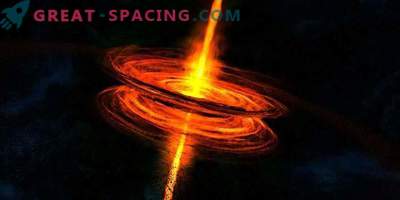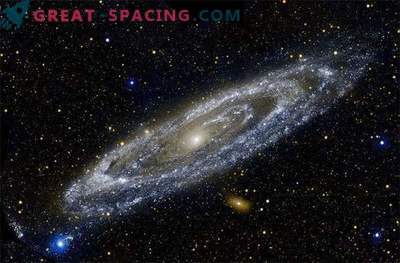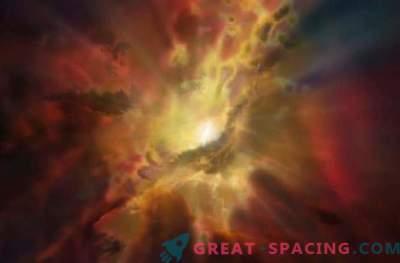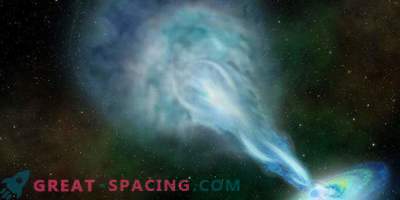
The image shows a region of space in which a quartet of rarely encountered quasars is located. On quasars show arrows. Quasars are immersed in a giant nebula consisting of a cold dense gas that looks like a blue haze in the image. The length of the nebula in diameter is one million light years. They are so far removed from the Earth that it takes about 10 billion years for their radiation to reach telescopes located on it. This artificial color image was obtained from observations of the Keck telescope provided at the Mauna Kea summit in Hawaii.
The quartet of quasars found by astronomers located in one area of cold gas will make it possible to make a discovery that alters the earlier theories about how these rare objects are formed. As Joseph Hennavi, a leading researcher at Max Planck’s German Astronomical Institute, noted in an interview with Discovery News, the significance of the discovery is that there are four of them, and they are so close to each other.
Astronomers consider it lucky to catch for a moment a single quasar that appears for an insignificant amount of time at the peak of the frantic absorption of a super-heavy black hole. The attraction of a substance to the center of a galactic black hole — an area with such powerful gravitation that even photons of light cannot leave it, does not last long, but causes shocks in an area near the black hole, accompanied by a glow whose brightness is hundreds of times greater than the light emitted by the galaxy , becoming the most luminous objects in the universe.
As a rule, quasars are single objects that separate hundreds of millions of light years. About 100 quasars were found in pairs. Among the quasars found in the Universe there are three triple clusters and the recently discovered single quartet.
“This made us extremely surprised, because we knew that quasars are extremely rare objects and it’s quite unlikely that the four of them are so close to each other,” Hennavi said via e-mail.
"The recently found four are 650 thousand light-years from each other, which may be equivalent to 25% of the distance separating the Milky Way from its nearest neighbor, the Andromeda galaxy," he added.
The likelihood that such a discovery is random is 1:10 000 000. This suggests that quasars are more likely to occur under more specific conditions than current models suggest. For example, four of quasars are located in one dense cloud of cooled gaseous hydrogen. In addition, it is located in a massive proto-cluster of galaxies.
"This may mean that the emergence of quasars contributes to such an unusual environment containing a large amount of gas and galaxies - conditions that were considered mutually exclusive," said Hennavi.
“Existing modern models of the formation of objects of the Universe have never imagined that there can be so much cold dense gas around. On the contrary, according to these models, the gas for such a massive object should be 1000 times hotter and 1000 times less dense,” he noted.
According to astronomer Michel Fumagalli of the University of Derhem, located in the UK, this discovery is a unique opportunity to consider the complex of the most massive structures in the Universe.
"Thanks to this discovery, we can go back about 10 billion years ago in time to see how massive clusters are formed," said Fumagalli, who was part of the team that discovered the triple quasar in 2013.
She noted that the quartet of quasars also gives an idea of how black holes can grow over time.











































